
Do Shrooms Go Bad in a Bag?
Magic mushrooms, or shrooms, can indeed go bad if stored improperly, especially in a bag. When shrooms are kept in a non-airtight bag, they are exposed to air, moisture, and temperature fluctuations, which can accelerate their degradation. Over time, these conditions can cause shrooms to lose potency, develop mold, or become contaminated with bacteria. To avoid these risks, it’s essential to store shrooms in a way that minimizes exposure to these harmful elements.
Moreover, storing shrooms in a bag without proper drying can lead to retained moisture, which creates an ideal environment for mold growth. Moldy shrooms are unsafe to consume and can lead to serious health issues, including respiratory problems and food poisoning. Therefore, while storing shrooms in a bag might seem convenient, it is crucial to ensure they are completely dry and the bag is airtight, or better yet, opt for a more secure storage method like a vacuum-sealed bag or an airtight container.
Recommended Strains
Diesel
|
|
THC | 12% - 21% (Medium) |
|
|
Type | Feminized |
|
|
Yield | High |
|
|
Phenotype | 30% Indica / 70% Sativa |
Diesel Autoflower
|
|
THC | 10% - 15% (Low) |
|
|
Type | Autoflowering |
|
|
Yield | Medium |
|
|
Phenotype | 40% Indica / 60% Sativa |
What Are Shrooms?
Shrooms, also known as magic mushrooms, contain the psychoactive compound psilocybin, which is responsible for their mind-altering effects. These mushrooms have been used for centuries in various cultures for spiritual and medicinal purposes. The effects of shrooms can vary greatly depending on the dose, the individual, and the environment, but typically include changes in perception, mood, and thought patterns. Many users often wonder, “Do shrooms go bad in a bag?”—the answer depends on storage conditions, as improper packaging can accelerate degradation and reduce potency over time.
The experience of taking shrooms can be broken down into several stages: onset, peak, come down, and after-effects. During the onset, users may begin to feel the first signs of altered perception, which can include visual and auditory distortions. The peak experience is often the most intense part of the trip, where hallucinations and profound changes in consciousness are most pronounced. As the effects begin to wear off, users enter the come-down phase, followed by after-effects that can linger for hours or even days.
Promos & Deals
How Long Do Shrooms Last?
The shelf life of shrooms depends largely on their storage conditions. Fresh shrooms, when stored in the refrigerator, typically last about 7-10 days before they begin to show signs of spoilage, such as sliminess or a funky odor. On the other hand, dried shrooms, if kept in an airtight container away from light and moisture, can last for a year or more without losing significant potency.
However, improper storage can drastically shorten their shelf life. For instance, shrooms stored in a humid environment or exposed to light will degrade much faster, losing both their potency and their safety for consumption. This is why it’s essential to store shrooms properly, using airtight containers and keeping them in cool, dark places.

Are Expired Shrooms Dangerous?
Yes, many people wonder, do shrooms go bad in a bag? The answer is yes—consuming expired or spoiled shrooms can pose serious health risks. As shrooms age, especially when stored in a bag, they can develop mold or bacterial contamination, which can cause food poisoning, allergic reactions, or even severe gastrointestinal distress. In addition, while expired shrooms may lose their potency, this does not mean they are safe to consume; the risk of contamination remains high.
It’s important to recognize the signs of spoilage in shrooms, such as a musty smell, unusual discoloration, or the presence of mold. If any of these signs are present, the shrooms should be discarded immediately. Consuming spoiled shrooms is not worth the risk, as the potential health consequences can be severe.
How to Dry Magic Mushrooms
Drying magic mushrooms is a crucial step in preserving their potency and extending their shelf life. The most effective method for drying shrooms is to use a food dehydrator, which removes moisture evenly without exposing the shrooms to excessive heat. Alternatively, air drying can be done by spreading the shrooms out on a wire rack in a well-ventilated area, turning them occasionally to ensure they dry thoroughly.
It’s important to note that shrooms should be dried slowly and carefully to prevent them from becoming too brittle or losing their psychoactive properties. Once dried, the shrooms should snap easily when bent, indicating that all moisture has been removed. Properly dried shrooms can then be stored for long periods without significant loss of potency, provided they are kept in an airtight container in a cool, dark place.
Best Methods of Storing Dried and Fresh Shrooms
Proper storage is key to maintaining the potency and safety of both dried and fresh shrooms. Many people wonder, do shrooms go bad in a bag? The answer is yes—storing shrooms in a bag, especially if it’s not airtight, can lead to moisture buildup and degradation. For dried shrooms, the best storage method is in an airtight container, such as a glass jar, with the addition of a desiccant packet to absorb any residual moisture. This setup should be kept in a cool, dark place, as exposure to light and heat can degrade the active compounds in the shrooms.
For fresh shrooms, refrigeration is essential to prevent spoilage. They should be stored in a paper bag or wrapped in paper towels to absorb excess moisture, and consumed within a week for best results. It’s also important to handle fresh shrooms with clean hands and tools to prevent contamination, as they are more susceptible to mold and bacterial growth.
Storing Shrooms in Airtight Containers
Using airtight containers is one of the best ways to store shrooms, especially dried ones. Airtight containers, such as glass jars or vacuum-sealed bags, protect shrooms from moisture, air, and light, which are the primary factors that cause them to degrade. By keeping these elements out, you can significantly extend the shelf life of your shrooms while maintaining their potency.
In addition to using airtight containers, it’s advisable to include a desiccant packet inside to absorb any remaining moisture. This is particularly important if you live in a humid environment or if your shrooms were not fully dried before storage. Store these containers in a dark, cool place to further protect the shrooms from potential degradation.
Storing Shrooms in a Refrigerator
Refrigeration is suitable for fresh shrooms, but it is not recommended for dried ones. Fresh shrooms can be kept in the refrigerator for about 7-10 days, preferably in a paper bag to prevent excess moisture build-up. This method helps slow down the natural spoilage process, allowing you more time to consume them.
However, storing dried shrooms in a refrigerator is not ideal because the cool, moist environment can cause them to rehydrate slightly, which can lead to mold growth. If you must refrigerate dried shrooms, ensure they are in a completely airtight container, but generally, it’s best to keep dried shrooms in a dark, dry cupboard at room temperature.
Storing Shrooms in a Freezer
Freezing shrooms is another option, especially for long-term storage. Many people wonder, do shrooms go bad in a bag, and the answer depends largely on how they are stored. When done correctly, freezing can preserve the potency of shrooms for several months or even years. However, it is crucial that the shrooms are completely dried before freezing, as any residual moisture can lead to ice crystals forming, which can damage the mushrooms’ cellular structure and reduce their effectiveness.
One downside of freezing is that frequent thawing and refreezing can introduce moisture, which could lead to spoilage. Therefore, only remove shrooms from the freezer when you are ready to use them. Vacuum-sealed bags or airtight containers are the best options for freezing, as they provide additional protection against moisture.

How to Store Wet (Fresh) Mushrooms
Fresh mushrooms are highly perishable and should be stored carefully to maximize their shelf life. The best method is to place them in a paper bag or wrap them in paper towels before refrigerating. This setup helps absorb excess moisture while allowing the shrooms to breathe, preventing them from becoming slimy or moldy too quickly.
It’s important to consume fresh shrooms within a week of storage, as they begin to degrade and lose potency after that time. If you need to store them longer, consider drying them instead, as dried shrooms can be kept for much longer without spoiling.
How to Tell When Dried Shrooms Have Gone Bad
Identifying when dried shrooms have gone bad is crucial to avoiding potential health risks. One of the most obvious signs of spoilage is the presence of mold, which can appear as fuzzy or discolored spots on the surface of the shrooms. Moldy shrooms should never be consumed, as they can cause serious health problems, including respiratory infections and allergic reactions.
Other signs of spoilage include a strong, unpleasant odor, which can indicate bacterial contamination, and changes in texture, such as soft spots or a slimy coating. Discoloration, especially if the shrooms turn black or dark brown, is another indicator that they are no longer safe to consume. If any of these signs are present, it’s best to err on the side of caution and discard the shrooms.
Mold
Mold is one of the most obvious and dangerous signs that your shrooms have gone bad. Mold can appear in various colors, including white, green, black, or blue, and typically has a fuzzy or velvety texture. If you notice any mold on your shrooms, it’s crucial to discard them immediately, as consuming moldy shrooms can lead to severe health issues, such as respiratory problems and food poisoning.
Mold thrives in moist environments, so it’s essential to ensure that your shrooms are completely dry before storage and kept in airtight containers to prevent moisture from getting in. If you’re unsure whether a spot is mold or just natural discoloration, it’s better to be safe and avoid consuming the shroom.
Discoloration
While some discoloration, such as blue bruising, is normal and not harmful, other color changes can indicate that your shrooms have gone bad. For example, if your shrooms turn black, dark brown, or develop any unusual colors, this could be a sign of bacterial contamination or other spoilage.
Discoloration is often accompanied by other signs of spoilage, such as a change in texture or smell. If you notice any discoloration that seems unusual or concerning, it’s best to discard the shrooms to avoid the risk of consuming contaminated or spoiled mushrooms.
Funky Smell
A strong, unpleasant odor is a clear indication that your shrooms have gone bad. Many people wonder, do shrooms go bad in a bag? Fresh and dried shrooms typically have an earthy, slightly musty smell, but if they start to emit a sour, sweet, or otherwise off-putting odor, this could be a sign of bacterial contamination. Such odors are often accompanied by other signs of spoilage, like discoloration or mold, and should not be ignored.
If your shrooms develop a funky smell, it’s safest to discard them immediately. Consuming shrooms with a bad odor can lead to serious health risks, including food poisoning and other adverse effects. Always trust your senses—if something smells off, it’s better not to take the risk.
How to Tell When Shroom-Infused Products Have Gone Bad
Shroom-infused products, such as chocolates or honey, can also go bad over time, though the signs might be less obvious than with whole shrooms. For instance, chocolates can develop a white, powdery coating known as “bloom,” which indicates the sugar or fat has risen to the surface due to temperature fluctuations. While bloom isn’t harmful, it can indicate that the product has been exposed to improper storage conditions, which might affect its potency.
Honey-infused shrooms, on the other hand, can crystallize over time. While crystallization is not a sign of spoilage, any unusual changes in texture or taste, such as a sour flavor, might indicate that the honey has begun to ferment or that mold is present. Always inspect your shroom-infused products carefully before consumption, and if in doubt, it’s best to err on the side of caution and discard them.
Factors Influencing Duration and Intensity
Several factors influence the duration and intensity of a shroom trip, including the freshness and storage of the shrooms, the dosage, and individual differences like metabolism and tolerance. Fresh shrooms often provide a more intense experience due to higher moisture content, which can affect the absorption rate of psilocybin in the body. On the other hand, dried shrooms might offer a more predictable potency, especially if stored properly to avoid degradation.
The environment in which shrooms are consumed also plays a significant role. A calm, familiar setting can help enhance the trip, making it more introspective and controlled. Conversely, consuming shrooms in a chaotic or uncomfortable environment can lead to a more intense, potentially overwhelming experience. Additionally, the presence of food in the stomach can delay the onset and reduce the intensity of the effects, as it slows the absorption of psilocybin.
Signs of Spoilage
Recognizing the signs of spoilage in shrooms is crucial to avoid adverse health effects. Spoilage can manifest in various ways, including visual changes like mold, discoloration, or the presence of soft, mushy spots. These signs often indicate that the shrooms have been exposed to moisture or were not dried or stored correctly.
Another common sign of spoilage is a change in smell. If your shrooms emit a sour, musty, or otherwise unpleasant odor, it’s likely that they have gone bad and should not be consumed. The texture can also provide clues—shrooms that feel overly soft, slimy, or brittle may be past their prime. Always inspect your shrooms carefully before consumption, and when in doubt, it’s safer to discard them.
Risks and Safety Considerations
While shrooms are generally considered safe when used responsibly, there are several risks to be aware of. One common question people ask is, do shrooms go bad in a bag? Proper storage is essential to maintain their quality and avoid spoilage. One of the primary concerns with shrooms is the potential for a “bad trip,” which can involve intense feelings of fear, anxiety, or paranoia. To minimize this risk, it’s important to start with a low dose, especially for those who are new to shrooms, and to consume them in a safe, supportive environment.
Contamination is another significant risk, particularly with fresh shrooms. Improper storage or handling can introduce bacteria or mold, which can lead to serious health problems. Always inspect shrooms before consumption, and discard any that show signs of spoilage. Additionally, those with pre-existing mental health conditions should consult with a healthcare professional before using shrooms, as they can exacerbate certain psychiatric symptoms.

Fresh Shroom Storage Tips
To keep fresh shrooms as long as possible, store them in a paper bag or wrap them in paper towels before placing them in the refrigerator. This method helps absorb excess moisture, which can lead to quicker spoilage if left unchecked. Fresh shrooms should be consumed within a week for the best results, as they begin to lose potency and spoil after that period.
For those who want to store fresh shrooms for longer periods, drying them is the best option. Once dried, shrooms can be stored in airtight containers for extended periods without significant loss of potency. However, it’s important to ensure they are completely dry before storage to prevent the growth of mold or bacteria.
Freezing: Pros and Cons
Freezing a bag of shrooms can be an effective way to extend their shelf life, particularly for long-term storage. The primary advantage of freezing a bag of shrooms is that it significantly slows down the degradation process, preserving the potency of the shrooms for several months or even years. However, it’s crucial to ensure that the shrooms are completely dry before freezing, as any remaining moisture can form ice crystals that damage the shrooms’ cellular structure.
On the downside, freezing can also pose risks if not done properly. Frequent thawing and refreezing can introduce moisture, leading to the growth of mold or bacteria. Additionally, some users report that freezing can slightly reduce the potency of shrooms, though this is generally minimal if they are properly dried and stored in airtight containers.
Innovative Storage Solutions
For those looking to maximize the shelf life and potency of their shrooms, innovative storage solutions such as vacuum sealing and using desiccants can be highly effective. Vacuum-sealing shrooms in Mylar bags with oxygen absorbers can protect them from light, moisture, and air, which are the main factors that cause degradation. This method can keep shrooms potent and safe for consumption for several years.
Another innovative storage method is to infuse shrooms into honey, creating a long-lasting edible. The honey acts as a natural preservative, keeping the shrooms fresh for up to a year or more. This method also has the added benefit of masking the taste of shrooms, making them more palatable for consumption.
Safety First: Handling and Consumption Tips
When handling shrooms, it’s important to maintain cleanliness to prevent contamination. Always wash your hands and use clean tools when preparing shrooms for storage or consumption. This reduces the risk of introducing bacteria or mold, which can lead to spoilage and health risks.
When it comes to consumption, start with a small dose, especially if you are new to shrooms or trying a new batch. This cautious approach allows you to gauge the strength of the shrooms and your body’s reaction to them. Always consume shrooms in a safe and comfortable environment, ideally with a trusted person present, especially if you are inexperienced. This can help reduce anxiety and ensure a positive experience.
Maximizing the Shelf Life of Shrooms
To keep your shrooms potent and safe for as long as possible, store them in a dark, dry, and cool environment. Consider using airtight containers with desiccants for dried shrooms and refrigerate fresh ones in a paper bag. By minimizing their exposure to light, air, and moisture, you can significantly extend their shelf life.
If you’re storing shrooms for the long term, consider vacuum sealing them or freezing them (if properly dried) to maintain their potency. These methods provide an extra layer of protection against environmental factors that can cause shrooms to degrade over time. Remember, proper storage is key to enjoying the full effects of your shrooms safely and effectively.
FAQs of Do shrooms go bad in a bag
Can shrooms go bad in a plastic bag?
Yes, shrooms can go bad if stored in a plastic bag, especially if it isn’t airtight. Plastic bags can trap moisture, which can lead to mold growth and spoilage. To extend their shelf life, store dried shrooms in an airtight container or vacuum-sealed bag.
How can I tell if my shrooms have gone bad?
You can tell if shrooms have gone bad by checking for signs such as mold, discoloration (other than blue bruising), a foul or funky odor, and a change in texture (e.g., mushy or slimy spots). If any of these signs are present, it’s best to discard the shrooms to avoid health risks.
Is it safe to eat shrooms with blue spots?
Yes, blue spots on shrooms are usually a sign of bruising, which is common and not harmful. This blue discoloration occurs when the psilocybin in the mushrooms reacts to physical damage. However, if the shrooms have other unusual colors or signs of mold, they should be discarded.
How should I store shrooms for the long term?
For long-term storage, the best method is to completely dry the shrooms and store them in a vacuum-sealed bag with desiccants to prevent moisture. You can also freeze dried shrooms to further extend their shelf life, but ensure they are stored in airtight containers to avoid freezer burn and moisture exposure.
What happens if I eat moldy shrooms?
Consuming moldy shrooms can lead to serious health issues such as food poisoning, allergic reactions, or respiratory problems. If you suspect your shrooms are moldy, it’s safest to discard them immediately. Always inspect your shrooms before consumption to ensure they are safe to eat.



















